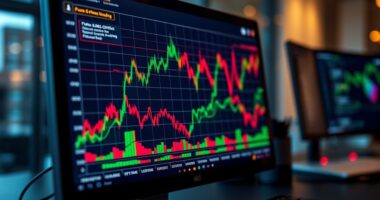The Fear & Greed Index can give you useful insights into market sentiment in 2025, but keep in mind its accuracy is limited. It captures investor emotions and behaviors, which can persist longer than expected or be influenced by external events. While it helps spot potential extremes, it shouldn’t be your only guide. To understand its strengths and weaknesses today, you’ll want to explore how it fits into the bigger picture of market analysis.
Key Takeaways
- The index offers a quick snapshot of market sentiment but may lag due to rapid behavioral and technological changes in 2025.
- It tends to be less reliable during macroeconomic or geopolitical shocks that it doesn’t account for.
- Sentiment can remain irrational longer than expected, limiting the index’s predictive accuracy.
- It should be combined with fundamentals and technical analysis for better investment decisions.
- Overall, it provides valuable insights but is not a definitive indicator of future market movements in 2025.

The Fear & Greed Index is a tool that helps you gauge market sentiment by measuring investor emotions and behaviors. In 2025, its relevance and accuracy remain topics of debate. You might wonder, can this index truly reflect the complex nature of investment psychology, or does it oversimplify what’s happening behind the scenes? While it provides quick insights into whether investors are feeling overly optimistic or excessively fearful, it’s essential to understand its strengths and limitations in the current market landscape.
Market sentiment, which the Fear & Greed Index aims to quantify, is a powerful driver of short-term price movements. When investors are driven by greed, they tend to chase gains, often inflating asset prices beyond their intrinsic value. Conversely, fear can lead to panic selling, pushing prices down sharply. This cyclical behavior is central to investment psychology, where emotions influence decision-making more than fundamentals. The index aggregates data points like volatility, trading volume, and momentum, attempting to translate these into a sentiment score. When the index signals extreme greed, it suggests the market could be overheated, while extreme fear indicates potential undervaluation or a buying opportunity.
However, the accuracy of the Fear & Greed Index in 2025 isn’t foolproof. Market sentiment can remain irrational longer than you expect, and the index doesn’t account for all variables, such as macroeconomic shifts, geopolitical events, or structural changes in the economy. It’s a snapshot, not a crystal ball. Relying solely on it can lead you astray, especially in a year marked by rapid technological advancements, regulatory changes, and evolving investor behaviors. Additionally, with the rise of algorithmic trading and passive investing, traditional sentiment indicators might not capture the full picture of current investment psychology.
Despite its limitations, the index still serves as a useful starting point. It helps you identify when the crowd might be overly optimistic or overly pessimistic, prompting you to dig deeper. Instead of taking the readings at face value, use them as part of a broader analysis that includes fundamentals, technicals, and your risk appetite. Remember, market sentiment is just one piece of the puzzle. In 2025, the index’s value lies in its ability to alert you to potential extremes, but it shouldn’t replace thorough research or your judgment.
Ultimately, the Fear & Greed Index can be a valuable tool if used wisely. It offers a quick pulse on investor emotions and can help you spot potential turning points. However, always keep in mind that market psychology is complex, and no single indicator can predict the future with certainty. Combining it with other analysis methods ensures you make more informed, balanced investment decisions. Recognizing emotional manipulation and biases can further enhance your understanding of market sentiment and improve decision-making.
Frequently Asked Questions
How Does the Fear & Greed Index Compare to Other Market Sentiment Indicators?
You want to know how the fear & greed index compares to other market sentiment indicators. It often provides quick insights into investor emotions, but its indicator reliability can vary in different market conditions. Compared to tools like the put-call ratio or volatility indices, the fear & greed index may be less precise but offers a broader sense of overall sentiment. Use it alongside other indicators for a more all-encompassing market sentiment comparison.
Can the Index Predict Sudden Market Crashes or Rallies Accurately?
You might wonder if the index can reliably predict sudden market crashes or rallies. While it reflects current market psychology and investor confidence, it isn’t foolproof. The index often signals extreme sentiment, but unexpected events can still trigger swift market moves. Use it as a tool to gauge overall mood, but don’t solely rely on it for predicting rapid market shifts—other factors and analysis are essential.
How Are the Components of the Index Weighted in Its Calculation?
You should know that the components of the index are weighted based on market sentiment and investor psychology. This means that factors like volatility, market momentum, and safe haven demand influence its calculation more heavily when investor feelings are extreme. The weighting adjusts dynamically to reflect current market conditions, helping you gauge overall investor mood. This approach aims to provide a thorough view, though it can sometimes oversimplify complex investor behaviors.
Does Investor Behavior Influence the Index More Than Economic Data?
You might wonder if investor psychology impacts market sentiment more than economic data. In reality, behavioral factors often sway the index more, as emotions like fear and greed drive buying and selling decisions. While economic data provides essential context, your perception and collective investor sentiment tend to influence short-term market movements more heavily. Understanding this helps you recognize how psychological trends can sometimes overshadow concrete economic indicators.
How Can Traders Use the Index to Inform Their Investment Strategies?
You can use the Fear & Greed Index to help avoid emotional trading and improve market timing. When the index shows extreme greed, consider reducing your holdings to lock in gains. Conversely, during extreme fear, look for buying opportunities. Remember, it’s a tool to complement your analysis, not replace it. Use it to gauge market sentiment and make more disciplined decisions, reducing impulsive moves driven by emotional trading.
Conclusion
In 2025, the Fear & Greed Index can give you some useful clues, but don’t rely on it alone. Market emotions are complex and ever-changing, so it’s best to use the index as just one part of your overall strategy. Stay informed, analyze other indicators, and trust your judgment. Remember, no single tool can predict markets perfectly—balance your approach for better decision-making.








